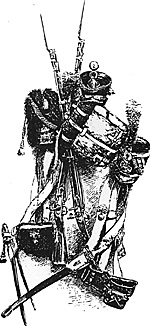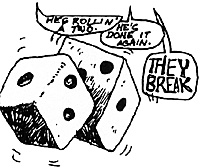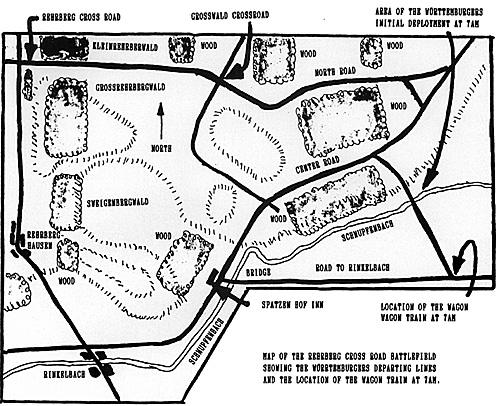 We were at the beginning of the Campaign of 1809.
A Wurttemberg force under the command of General
Freiherr von Gilbert von Jamesburg received orders to
escort a precious shipment to safety during the initial
Austrian push of that Campaign.
We were at the beginning of the Campaign of 1809.
A Wurttemberg force under the command of General
Freiherr von Gilbert von Jamesburg received orders to
escort a precious shipment to safety during the initial
Austrian push of that Campaign.
Unfortunately for von Gilbert, a dispatch concerning his mission had been captured by the Austrians and Archduke Charles decided to intercept that precious convoy. Thus, he gave command of an improvised task force to a young aggressive commander, FML von Jessop.
Austrian Forces:
FML von Jessop
Brigade GM Winzingerode
- Mahr Jager (1 battalion)
1st Jager (1 battalion)
3rd Jager (1 battalion)
Brigade GM Dollmeyer von Provencheres
- 4th, 5th, 6th Vienna Volunteers (3 battalions)
Grenz Regiment #6 (2 battalions)
6-lb. Brigade Battery (8 guns)
Brigade GM von Nordmann
- Hussars #7 (8 squadrons)
Chevau-1egers #6 (8 squadrons)
6-lb. Cavalry Battery (6 guns)
Wurttemberg Forces
GL Freiherr von Gilbert
Cavalry Division: GL Freiherr von Wo11warth
- Brigade GM Freiherr von Roeder (8
squadrons)
Brigade GM Freiherr v. Stettner (8 squadrons)
6-lb. Horse Battery (6 guns)
Infantry Division: GL Baron von Neubronn
- Light Brigade GM von Hugel (3 battalions)
Brigade GM von Franquemont (5 battalions)
6-lb. Foot Battery (8 guns)
Wagon Train Escort (1 battalion)
Starting
Von Gilbert entered his command on the road to Rinkelbach. He had to exit his command and his precious train at the Rehrberg crossroad.
Part of von Gilbert's command had crossed over the River Schnupfenbach unopposed during the night. That is, all his infantry and a cavalry brigade (eight squadrons), less an infantry battalion left as the escort of the wagon train.
At 7 A.M., von Gilbert started moving his command as follows:
- (1) Cavalry patrols were sent west, ahead of
the projected route;
(2) The wagon train was put in motion toward the crossroad at Rehrberg via the northernmost and easternmost road route;
(3) The command already over the bridge was also sent toward the Rehrberg crossroad, with the line infantry brigade on the central road, and the light brigade on the north road;
(4) The second cavalry brigade (von Stettner) moved via the south road to cross over the River at the Spatzen Hof bridge.
Von Jessop was not inactive either, but not sure of von Gilbert's whereabouts, he sent numerous cavalry patrols supported by some detached chevau-1eger squadrons. These patrols came into contact with von Gilbert's forces at 7:20 A.M. and the first encounter took place at 7:30 when a lone, bold Austrian squadron tried, single handed, to prevent an entire cavalry brigade from crossing over the bridge near the Spatzen Hof Inn. This impetuous attack struck the first Wurttemberg squadron as it came across the bridge. The Wurttemberg squadron barely had time to deploy and counter-charge. Full of confidence because of strong support on and beyond the bridge, the Wyrttembergers defeated (minor defeat) the Austrian squadron after a ten minute clash.
Also at 7:30, the Wurttemberg cavalry patrols spotted a detachment of Austrian light infantry near the Grosswald crossroad. The Austrian vedettes spotted enemy cavalry progressing on the center road, followed by infantry.
At 7:40 on the southern front, a second squadron of chevau-1egers tried and failed to prevent the Wurttembergers from crossing the bridge. However, these two Austrian defeats bought the time necessary for a full Austrian hussar regiment (eight squadrons) to deploy behind the Spatzen Hof Inn and a cavalry battery unlimbered just at the northeast comer of the Inn. Meanwhile, the rest of the Wurttemberg cavalry crossed over the bridge near the Spdtzlen Hof Inn.
The time was now 7:50 AM. and the situation was changing fast.
In the center, the Austrians had only four squadrons supporting their patrols. Outnumbered by the enemy cavalry they withdrew. So did the Austrian light infantry brigade now facing the Wurttemberg light infantry brigade near the Grosswald crossroad. The Wurttembergers continued their advance.
But near the bridge, their opponents were full of combativeness and the Austrians, favored by the Spatzen Hof Inn, charged the Wurttemberg cavalry from two sides, both on the northeast and southeast sides of the inn.
Two Austrian squadrons faced two Wurttemberg squadrons. Victory for the Austrians on either side of the inn would have been glorious, as the Wurttembergers would have been pushed into the river. In spite of their artillery support and their superior position all Austrian efforts were repulsed. As this battle raged, a single Austrian hussar squadron was dispatched east on the center road, completely unopposed and obviously in search of the wagon train. On the other side of the river, the Wurttembergers unlimbered their horse battery.
At 8:00 A.M. in the north, both Wurttemberg infantry brigades had advanced far enough west of the crossroad to spot an unlimbered Austrian battery between the Grossrehrbergwald and the Kleinrehrbergwald woods. The Austrian light infantry withdrew further west and entered the Kleinrehrbergwald.
In the south, the defeated Austrian cavalry withdrew in good order from the inn region towards Rehrberghausen. At this time the quiet center was occupied by six squadrons of Wurttemberg cavalry, faced by the slowly regrouping (from their patrol duties) Austrian chevau-1egers. The six Wurttemberg squadrons would soon be reinforced by the entire victorious brigade and horse battery at the Spatzen Hof Inn. The remainder of the battle would be fought on a north-south axis in and around the two large woods on the northeast portion of the map and the ground to the immediate east of these woods.
At 8: 10, a squadron of Wurttemberg cavalry in skirmish order charged the Austrian battery deployed between Grossrehrbergwald and the Kleinrehrbergwald woods, but canceled their charge as Austrian infantry popped out from both woods. The train was finally spotted on the north road by the Austrian hussar squadron that had been progressing on the center road. The train was escorted by a battalion of infantry.
At 8:20, in the center, four squadrons of Wurttemberg cavalry charged four Austrian squadrons. The Wurttemberg battery did not arrive in time to support that charge. The Austrians, after a short combat (10 minutes), suffered another minor defeat and fell back as the four victorious squadrons reformed.
At 8:30, another four Wurttemberg squadrons charged the other four fully regrouped Austrian chevau- 1eger squadrons in the valley between the Sweigenbergwald and Grossrehrbergwal d. Both sides were supported by artillery. Some Austrian infantry popped out from the Grossrehrbergwald and took in enfilade the charging Wurttembergers which were routed during a short combat (10 minutes). The defeated cavalry withdrew some 1,500 yards to rally and reform (the rallying and reforming of the defeated cavalry took one hour). This rout, combined with the arrival of the Austrian hussars, brought the aggressive Wurttemberg cavalry to a halt.
At 8:50, the Wurttemberg line infantry brigade moved toward the center to take position, deploying on a line of columns at deploying distance, about 1,000 yards away from the Grossrehrbergwald wood and out of range of the Austrian artillery battery located between the Grossrehrbergwald and the Kleinrehrbergwald.
At 9:00, that infantry was ordered to charge and capture the Grossrehrbergwal d. Since the wood was 1,000 yards from the line of departure, over 10 minutes were necessary to reach the wood. During the attack, the Wurttemberg infantry, supported at long range by their foot battery, came under fire from the Austrian battery. The edges of Grossrehrbergwald came alive with volleys from the three battalions of Vienna Volunteers infantry that occupied it.
Shortly after 9:10, contact was made by the two opposing forces and after a short combat (about 10 minutes) the Austrians were expelled from the wood. The Austrian battery deployed between Grossrehrbergwald and the Kleinrehrbergwald woods, not under attack, had limbered at the time of impact and withdrew during the combat.
At 9:30, two battalions of the Wurttemberg light infantry brigade, supported by the foot battery, attacked the Kleinrehrbergwald occupied by two Jagers battalions. The Austrians were expelled from the wood after a 20 minute combat.
The situation did not look good for the Austrians!
Also at 9:30, the Austrians counterattacked in an attempt to recapture the Grossrehrbergwald with two fresh Grenz battalions that had been deployed in line behind that wood. It would be 30 long minutes before the outcome of this combat would be known by the commanders. By 10:00 A.M. the Grenz defeated the Wurttembergers and kicked them out of the woods.
During these long infantry combats in the Grossrehrbergwald and the Kleinrehrbergwald, the Austrian commander, fearing his defeat was at hand, decided to launch a series of cavalry charges to stop the Wurttembergers. The first charge took place at 9:30 when a single Austrian squadron in skirmish order charged the Wurttemberg foot battery deployed west of the Grosswald crossroad that was unsupported.
 The artillery battery was quickly overrun and some 25% of
the artillerists were killed, wounded or taken prisoners
in the process. The survivors desperately ran for their
lives and abandoned their guns.
The artillery battery was quickly overrun and some 25% of
the artillerists were killed, wounded or taken prisoners
in the process. The survivors desperately ran for their
lives and abandoned their guns.
Then, at 9:40 the second series of charges took place both north and south of the Grossrehrbergwald. To the south, three squadrons of Austrian hussars supported by their cavalry battery, charged through the gap between Sweigenbergwald and Grossrehrbergwald, followed by a second line of four squadrons. Their intent was to engage and keep the attention of some twelve squadrons of Wurttemberg cavalry.
At the same time in the gap between the Grossrehrbergwald and the Kleinrehrbergwald woods, five squadrons of Austrian chevau-16gers supported by a second line of two squadrons, followed the 9:30 single-squadron attack. The Austrian horsemen charged five squadrons of Wurttemberg cavalry defending the wagon train at the Grosswald crossroad, which consisted of six squadrons in total (four of which were under strength and had just rallied from their prior rout). In all the 9:40 combats, the Wurttembergers were defeated. At the crossroad, the Wurttembergers had to rally far away, as an Austrian hussar squadron was in their rear.
In a few minutes the tide had completely changed and now it was the Wurttembergers who were in a sad shape. At 9:50, in the north, the last weak Wurttemberger squadron was defeated near the wagon train. A successful delaying action was launched by a single Austrian chevau-1eger squadron against three Wurttembergers squadrons dispatched from the south to save the wagon train. This delay bought the time necessary to rally the bulk of the chevau-1egers near the train.
A second victory by the Austrian hussars to the south forced the Wurttemberger cavalry away from the western side of the woodlines.
At 10 A.M. the wagon train was captured and the Wurttemberger line infantry abandoned the Grossrehrbergwald woods to find their flanks and rear infested with Austrian horsemen.
It was a good battle. It was a hard task for both sides and Freiherr von Gilbert von Jamesburg almost made it. Von Gilbert and his Wurttembergers had a clear upper hand until about 10 A.M., since they had managed to capture the Grossrehrberguwald and the Kleinrehrbergwald woods key to the Rehrberg crossroad, but two Grenz fresh battalions made the difference (combined with a bad die throw for Gilbert). In addition, the Wurttembergers lost their foot battery left carelessly unsupported near the Grosswald crossroad. That was a major mistake that Von Jessop could not avoid taking advantage of. Well, c'est la guerre!
FML von Jessop's Battle Report
I was not myself the day of the battle, perhaps it was the board of inquiry hearing scheduled for next week, which could spell the end of my military career. My orders varied on the day from aggressive, to timid, and back to aggressive. For most of the battle my opponent, venerable von Gilbert, played me like a cheap string instrument.
The intent of my initial orders was not to prevent the exit of the wagon train, but to capture it. Brigade Wintzingerode was ordered to skirt the north edge of the field to the woods west of the Rehrhausen crossroad, there to await in ambush for the passing train. Nordmann's cavalry brigade was to be divided into two forces: a scouting force consisting of pairs of chevau-16ger squadrons, to probe eastward for the enemy and their wagon train, and my masse de decision consisting of the hussar regiment and cavalry battery, which were to hide in the terrain east of the Spatzen Hof Inn, so as to engage the enemy in flank and rear once he was found. Not being a total fool, I ordered Brigade Dollmeyer to defend in and around the Grossrehrbergwald.
From dawn's early light, everything went wrong. My pickets reported hoards of Wurttembergers everywhere. I felt outnumbered on all fronts. Brigade Wintzingerode was spotted before reaching its ambush position so it was withdrawn to Kleinrehrbergwald. Nordmann's hussars were pulled into the battle at Spatzen Hof, and failed to prevent the river crossing. By 8:00 A.M., the desire to attack had left me. Aside from one hussar squadron acting in the enemy rear, all cavalry was ordered to defend the region south of Grossrehrbergwald.
At 9:20, The Vienna Volunteers ran past my position behind Grossrehrbergwald. I was demoralized and outnumbered, having won but one of the many engagements so far that day. I did not feel I could hold the position, but perhaps there was still an opportunity to capture the wagon train reported to be at the Grosswald crossroad. Desperate orders were dispatched to all commands.
Brigade Wintzingerode was ordered to sally out of the Kleinrehrbergwald and attack the enemy light brigade and battery in front of the wagon train, and then take the wagon train itself. This attack would be supported by the chevauleger regiment which, using the Grossrehrbergwald for cover, could redeploy to the north of this wood in secrecy, essentially "stealing a march" from the Wurttemberg cavalry hoards to the south. The hussars would aggressively engage the aforementioned enemy horseman so as to prevent them from supporting the wagon train to the north. Lastly, Dollmeyer's Grenzers were thrown into the Grossrehrbergwald to retake the woods or, at the very least, delay the victorious enemy infantry.
Wintzingerode's light brigade was heavily engaged before it received its new orders. This turned out to be to my advantage as three battalions of fresh enemy infantry were now away from the wagon position, giving my chevau-legers a wide open avenue of assault. The wagon defenders were now inadequate against the eight squadrons of chevaulegers, and single hussar squadron in their rear.
My hat is off to von Gilbert for destroying me both physically and mentally throughout the battle. But I hope that he learned today that a cornered and wounded enemy can be the most dangerous of opponents.
(See Mike Gilbert's interpretation of the battle in Friday Night at the Fights p.62.)

Back to Empire, Eagles, & Lions Table of Contents Vol. 2 No. 7
Back to EEL List of Issues
Back to MagWeb Master Magazine List
© Copyright 1994 by Emperor's Headquarters
This article appears in MagWeb (Magazine Web) on the Internet World Wide Web.
Other military history articles and gaming articles are available at http://www.magweb.com
